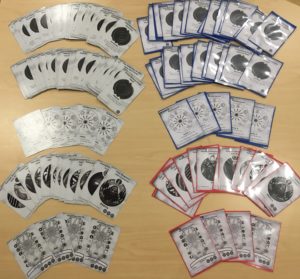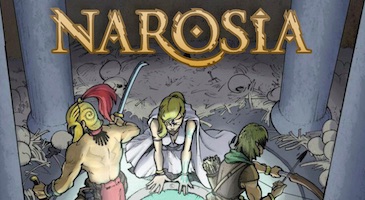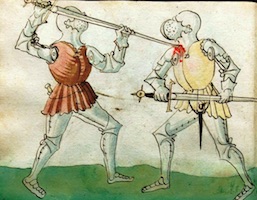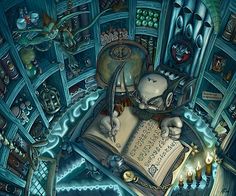This is pretty much covered in Ultimate Martial Artist, but since it came up in a discussion I thought it easier to post it here. The focus of that discussion was on Half-Swording, both as a grappling technique and an armor minimizing technique. I think both of those approaches requires training, so I don’t think it is something that someone who hasn’t studied sword fighting as a martial art could do (as opposed to simply being able to not wound themselves while swinging a sword).
In the Martial Art below you can see there are 3 Half-Sword maneuvers for disarming, grappling, and penetrating. The Half-Sword Strike maneuver adds +4 Damage Classes, which for an average man using a Broadsword doubles the damage of the weapon. HERO is a “Armor Stops Damage” type system, and plate armor stops 7 points or more, depending on the craft of the armor. This is perfect, because the average man wielding a broadsword has a max damage of 7. However, even without additional strength or magic weapons, that combatant could deliver, essentially, their normal damage to a fully armored opponent which, ultimately, is the point of the maneuver.
Now, in d20 armor doesn’t stop damage, so applying this maneuver directly (by increasing damage) doesn’t really translate well. However, negating the target’s Armor Bonus to AC does. Since in d20 Plate is AC +8, reducing that to +4 has roughly the same intended effect as in HERO. Now, whether you interpret that to be cutting the Armor Bonus in half or reducing it by 4 is up to you. I’d go with cutting it in half to allow this maneuver to work on all types of armor without totally eliminating the value of that armor.
So, the Half-Sword Strike maneuver in d20 would be a Standard Action that reduces your AC by 2 while cutting your target’s Armor Bonus in half. Whether that is a Feat or just something that Fighters can do is up to you. Of course, you can always just play HERO either in an established setting like Narosia: Sea of Tears or by rolling your own with Fantasy Hero Complete.
Swordfighting
Those familiar with HERO will have no problem understanding this. However, I thought I might describe it in d20 terms (see below).
| Maneuver |
Phase |
OCV |
DCV |
Effect |
Cost |
| Counterstrike |
1/2 |
+2 |
+2 |
Weapon +2 DC Strike, Must Follow Block |
4 |
| Lock |
1/2 |
+1 |
+0 |
Bind, +10 STR |
4 |
| Parry |
1/2 |
+2 |
+2 |
Block, Abort |
4 |
| Slash |
1/2 |
+0 |
+2 |
Weapon +2 DC Strike |
4 |
| Thrust |
1/2 |
+1 |
+3 |
Weapon Strike |
5 |
| Trip |
1/2 |
+1 |
+1 |
Weapon Strike; Target Falls, Requires Both Hands |
3 |
| Half-Sword Disarm |
1/2 |
-1 |
+1 |
Disarm, +10 STR to Disarm roll, Requires Both Hands |
4 |
| Half-Sword Trip |
1/2 |
+2 |
+0 |
Weapon Strike, Target Falls, Requires Both Hands |
3 |
| Half-Sword Strike |
1/2 |
+0 |
-1 |
Weapon +4 DC Strike, Requires Both Hands |
4 |
| Weapon Element |
|
|
|
Blades and clubs (no unarmed use) |
1 |
|
|
|
|
Total Cost |
36 |
Phase: 1/2 means that this is a Standard Action
OCV: This is the modifier to your Attack Roll
DCV: This is the modifier to your AC until the start of your next Action
Effect: This is the result of the maneuver. Weapon Strike is your base weapon damage, +X DC is a damage bonus, and STR is Strength. Block, Abort, and Bind are all HERO-y things that don’t really apply in d20.
Attack Roll & AC bonuses are on a 3d6 curve; rough conversion to d20 is to double them
 One of my original objectives with Narosia was to create a pantheon of gods that were actively involved in the world and the story of the characters, all the while retaining the trappings of fantasy roleplaying that decades later we still enjoy. I did this by keeping the size of the pantheon small (12 gods), establishing threats in the world that were not controlled by the gods (the Fel and the Qliphothic), and creating a system of cards that enabled the players to control the influence of the gods in the current adventure.
One of my original objectives with Narosia was to create a pantheon of gods that were actively involved in the world and the story of the characters, all the while retaining the trappings of fantasy roleplaying that decades later we still enjoy. I did this by keeping the size of the pantheon small (12 gods), establishing threats in the world that were not controlled by the gods (the Fel and the Qliphothic), and creating a system of cards that enabled the players to control the influence of the gods in the current adventure.



